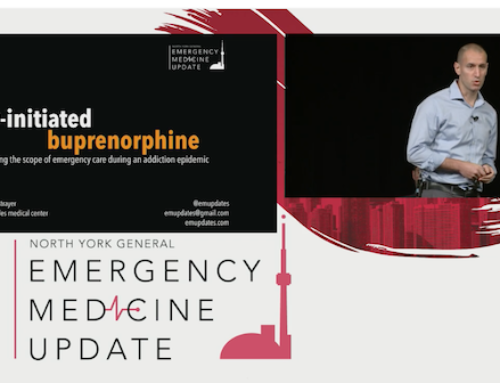EMU 365: Everything you need to know about TIA in 10 min
We know that 10-15% of strokes are preceded by TIAs, with 50% of these strokes occurring within 48hrs of a TIA. We need to be better as emergency physicians at catching the sentinel event. Dr. David Carr highlights at EMU 2019 his pearls in TIA diagnosis, workup and management: respect the eyes, look for the Crochetage sign on ECG, urgent head and neck imaging and dual antiplatelet agents for high risk patients…
Pearls in TIA diagnosis, workup and management
Diagnosis:
- TIAs present with negative symptoms (lack of function): loss of sensory, motor, speech and/or vision. Common mimics like migraines will ‘march’ with positive symptoms of pain, scintillating scotomas etc.
- Respect the eyes, visual field deficits =/= retinal pathology, patients with retinal TIAs need the same stroke workup
Workup:
- Get urgent (<24hrs) head and neck imaging for your high-risk TIA patients: CT or MRI and vascular imaging (CTA or MRA) from aortic arch to vertex
- ECG
- Atrial fibrillation. **Remember to ask about TIA symptoms before you cardiovert a patient
- Crochetage sign (notch in apex of R wave) seen in II, III, aVF is highly specific sign of the presence of a PFO or ASD
Outpatient management for high-risk TIAs:
- Dual antiplatelets (FASTER, CHANCE, POINT trials)
- Load with ASA 160-325mg chewed followed by ASA 81mg po daily
- Load with Clopidogrel 300mg po followed by 75mg po daily for 3 weeks only
Speaker Bio
Dr. David Carr is an Associate Professor in the Division of Emergency Medicine at the University of Toronto. He serves as the Assistant Director of Risk Management and Faculty Development at the University Health Network in Toronto. He has been the recipients of both Undergraduate and Post Graduate Clinical Teaching awards. During the Baseball season, he works at the Roger’s Centre as the Medical director of stadium medicine for the Toronto Blue Jays.




The problem with “negative” Vs “positive” symptoms, is that we do see (verified) strokes and TIA’s with positive symptoms – so I would suggest considering “negative” symptoms as a high LR test, and the “postive” symptoms as a low LR test. However if your pre-test probability is high (sudden onset, with other focal symptoms that are neuroanatomically sound etc), I would NOT rule out stroke on the basis of “positive symptoms”. Especially amaurosis fugax is tricky, as UptoDate and the litterature describes positive symptoms being commonplace – however I do not know what they use for their gold-standard test (i.e how do you confirm a TIA?).
To know TIA’s you need to know FND (functional neurological disorder), and how they present (i.e read anything by Jon Stone and Hallet – especially handbook of neurology vol 139, and read Susanne O’sullivans: it’s all in your head, and Andersson: Functional (Psychogenic) Neurological Disorders: Assessment and Acute Management in the Emergency Department). You need to be able up the mimicks like that
The “migraines that migrate” are easier, but STILL it’s possible for stroke / TIA (especially thalamic stroke/TIA), and I would, again, refer this as a “low LR”-test
For me it all depends on the pre-test probability, and how much the symptoms suggest TIA (and how much they are neuroanatomically regular), what symptoms (hierachy of TIA symptoms with sensory loss at the bottom)
All the best
Peter (ED resident with subinterest in neurological emergencies, Denmark/sweden)
What data is the stated NNT for carotid endarterectomy based on?